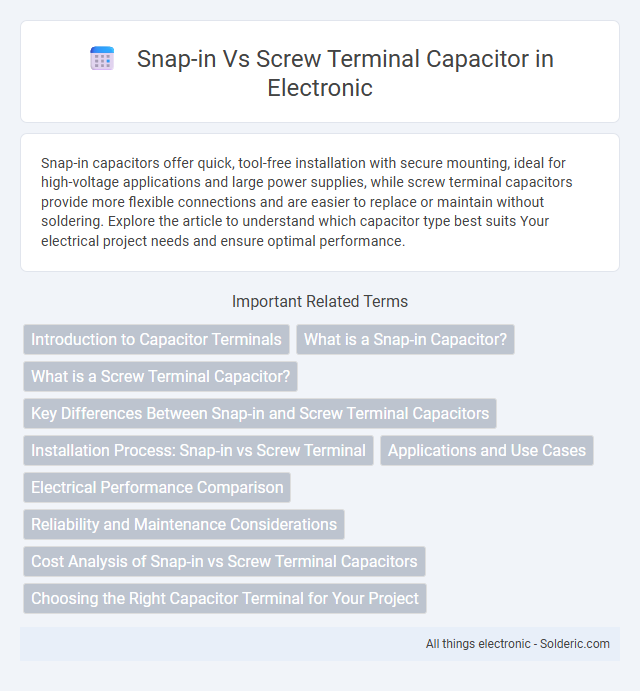Snap-in capacitors offer quick, tool-free installation with secure mounting, ideal for high-voltage applications and large power supplies, while screw terminal capacitors provide more flexible connections and are easier to replace or maintain without soldering. Explore the article to understand which capacitor type best suits Your electrical project needs and ensure optimal performance.
Comparison Table
| Feature | Snap-in Capacitor | Screw Terminal Capacitor |
|---|---|---|
| Mounting Type | Snap-in pins for PCB or chassis mounting | Screw terminals for direct wiring connection |
| Installation Speed | Faster, tool-free installation | Slower, requires tools to tighten screws |
| Connection Reliability | Good for secure PCB connections | Superior mechanical and electrical connection |
| Application | HVAC, motors, filter circuits | Industrial, high current, heavy-duty applications |
| Maintenance | Less convenient for replacement | Easy to disconnect and replace |
| Size Range | Typically smaller, compact | Often larger, designed for heavy-duty loads |
| Cost | Generally lower cost | Typically higher cost due to robust design |
Introduction to Capacitor Terminals
Snap-in terminals offer quick installation and secure connections for capacitors, commonly used in high-frequency and power applications. Screw terminals provide robust mechanical stability and are preferred for heavy-duty or high-vibration environments due to their strong clamping force. Selection depends on factors like ease of assembly, electrical performance, and environmental conditions.
What is a Snap-in Capacitor?
A snap-in capacitor is a type of electrolytic capacitor commonly used in power supplies and electronic circuits for smoothing and filtering applications. It features sturdy metal leads that snap securely into circuit board holes or chassis, offering reliable mechanical stability and easy installation. Snap-in capacitors typically provide higher capacitance values and voltage ratings compared to screw terminal capacitors, making them ideal for high-current or high-voltage applications.
What is a Screw Terminal Capacitor?
A screw terminal capacitor features metal terminals secured by screws, providing a reliable and durable electrical connection ideal for high-current applications. This design allows for easy maintenance and secure attachment, reducing the risk of loose connections and enhancing overall circuit stability. Your choice of a screw terminal capacitor ensures robust performance in environments subject to vibration or frequent disassembly.
Key Differences Between Snap-in and Screw Terminal Capacitors
Snap-in capacitors feature quick installation through spring-loaded pins, making them ideal for automated assembly, while screw terminal capacitors require manual fastening using screws, offering greater connection security and ease of maintenance. Snap-in designs are commonly used in high-volume production due to their efficient mounting, whereas screw terminals provide enhanced reliability for applications subject to vibration or frequent servicing. Understanding these key differences helps you select the capacitor type best suited for your specific electrical or electronic system needs.
Installation Process: Snap-in vs Screw Terminal
Snap-in capacitors feature pre-attached terminals that quickly snap into place, reducing installation time and minimizing the need for specialized tools. Screw terminal capacitors require manual tightening of screws to secure the wires, which provides a more robust mechanical and electrical connection but takes longer to install. The snap-in design is favored in high-volume production environments, while screw terminals are preferred for applications demanding enhanced durability and ease of maintenance.
Applications and Use Cases
Snap-in capacitors are ideal for high-voltage power supplies, electric motor run circuits, and HVAC systems where quick installation and reliable, vibration-resistant connections are critical. Screw terminal capacitors suit applications requiring frequent maintenance or replacement, such as industrial machinery and large electrical panels, due to their secure and easily accessible connection points. Understanding your specific equipment needs will help you choose between the rapid installation of snap-in or the service-friendly design of screw terminal capacitors.
Electrical Performance Comparison
Snap-in capacitors offer lower equivalent series resistance (ESR) and inductance compared to screw terminal capacitors, which enhances their high-frequency performance and efficiency. Screw terminal capacitors provide more secure mechanical connections, reducing contact resistance and improving reliability in high-vibration environments. Your choice should consider the specific electrical requirements, as snap-in capacitors excel in fast-switching applications while screw terminals are better for robust, long-term installations.
Reliability and Maintenance Considerations
Snap-in capacitors offer enhanced reliability due to their secure, vibration-resistant connections, reducing the risk of loose contacts and electrical failure in high-vibration environments. Screw terminal capacitors provide straightforward maintenance and easy replacement, allowing quick disconnection and reconnection without specialized tools. Your choice should balance the need for durable, maintenance-free operation with the convenience of easy servicing depending on your application requirements.
Cost Analysis of Snap-in vs Screw Terminal Capacitors
Snap-in capacitors generally offer a lower cost due to their streamlined manufacturing process and ease of automated assembly, reducing labor expenses. Screw terminal capacitors tend to be more expensive because of their robust design, which provides better mechanical stability and ease of maintenance in high-vibration environments. Your choice should balance initial investment against long-term durability and maintenance needs to optimize overall cost efficiency.
Choosing the Right Capacitor Terminal for Your Project
Choosing the right capacitor terminal is crucial for project reliability and ease of assembly. Snap-in terminals offer fast installation and strong mechanical stability, making them ideal for high-volume production and applications requiring vibration resistance. Screw terminals provide superior connection security and flexibility for maintenance or replacement, suitable for projects where frequent adjustments or high current capacities are expected.
Snap-in vs screw terminal capacitor Infographic

 solderic.com
solderic.com